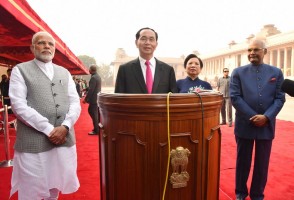
India’s life sciences industry has potential to become $200 bn industry: FICCI report
Union Minister for Health and Family Welfare J P Nadda released the FICCI knowledge paper ‘Indian life sciences: Vision 2030 – Expanding global relevance and driving domestic access’ at the FICCI Life Sciences Conference in the capital today. The theme which centred on ‘Pharma Vision 2030: Building India’s Global Relevance’ was attended by a host of government officials and industry professionals. In his inaugural address, Nadda highlighted that the government was in the process of amending the Drugs and Cosmetics Act to encourage innovation and the entrepreneurial spirit of manufacturers. Speaking on research and development (R&D), he said that Indian pharma companies are spending less than 2% of their total turnover on R&D. “It is time that the Indian life sciences industry focuses on the development of new molecules and innovations. The window period of 2015-18 is very critical when the patent tenure of many bio-pharmaceuticals and innovative molecules will expire,” he said. The Indian life sciences industry is now the third largest contributor to reducing India’s merchandise trade deficit. The industry generates around $10 billion of trade surplus every year, allowing it to neutralise around 4-5% of total energy imports for India. In addition, it can also be credited for generating jobs and self-employment for around 2.5 million. Dr Jyotsna Suri, President, FICCI, said that the sector was undoubtedly facing challenges such as the changing market scenario and business dynamics, pressure on pricing and margins, regulatory hurdles and growing dependence on China for intermediates. “The sector looks to the government for support. If successful, the sector would contribute to the healthcare and economy both for India and the world. It would also create about 4 million additional jobs over the next 15 years,” she said. In pharmaceuticals, India is now the eighth largest country by value globally with one of the highest growth rates. It is strongly positioned in key overseas markets like USA. In clinical trials, India continues to be one of the top 15 destinations globally. Moreover the Indian medicine industry has also built strong value chain capabilities. In manufacturing, India continues to have the highest number of FDA approved formulation plans outside the US. In R&D and regulatory, Indian industry has accounted for 32% of the ANDA filings last year, second only to the US at 44%. Vision 2030 builds on the successful trajectory of the Indian life sciences industry, laying out the path forward. FICCI believes that by achieving Vision 2030, the industry will make significant contribution to the economy and healthcare outcomes. As per the knowledge paper, the industry can sustain its growth trajectory of 11 to 12% and grow 7 to 8 times to $190 or $200 billion. This would drive 5-6 times growth in trade balance contribution to around $55-$60 billion and would also create nearly 4 million new jobs for the country over the next 15 years by the year 2030.
June 05, 2015 | 8:56 pm IST.






 to success.
to success.